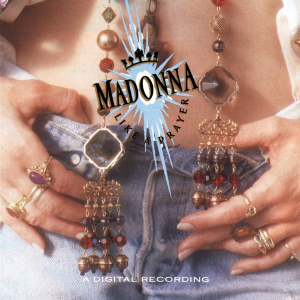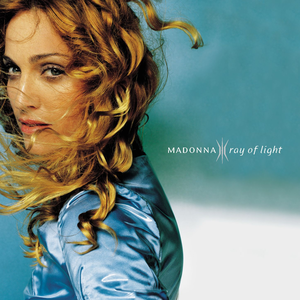
Madonna Louise Ciccone is an American singer, songwriter, and actress. Known as the "Queen of Pop", Madonna has been widely recognized for her continual reinvention and versatility in music production, songwriting, and visual presentation. She has pushed the boundaries of artistic expression in mainstream music while maintaining control over every aspect of her career. Her works, which incorporate social, political, sexual, and religious themes, have generated both controversy and critical acclaim. A prominent cultural figure spanning both the 20th and 21st centuries, Madonna remains one of the most "well-documented figures of the modern age", with a broad array of scholarly reviews, literature, and art works about her, as well as an academic mini subdiscipline devoted to her called Madonna studies.

Like a Virgin is the second album by American singer and songwriter Madonna, released on November 12, 1984, by Sire Records. Following the success of her self-titled debut album, Madonna chose Nile Rodgers to produce the album due to his work with David Bowie. Madonna wrote six songs on the record, five of which feature Steve Bray as a co-writer. The album was recorded at Power Station Studio in New York at a quick pace. Rodgers enlisted the help of his former Chic bandmates Bernard Edwards, who was the bassist, and Tony Thompson, who played drums. Jason Corsaro, the record's audio engineer, persuaded Rodgers to use new digital recording methods.

Who's That Girl is the first soundtrack album by American singer and songwriter Madonna. It was released on July 21, 1987, by Sire Records to promote the film of the same name. It also contains songs by her label mates Scritti Politti, Duncan Faure, Club Nouveau, Coati Mundi and Michael Davidson. The soundtrack is credited as a Madonna album, despite her only performing four of the nine tracks on the album. After the commercial success of the film Desperately Seeking Susan (1985), in which she co-starred, Madonna wanted to act in another comedy film titled Slammer, about a woman named Nikki Finn who was falsely accused of homicide. However, due to the critical and commercial failure of her adventure film Shanghai Surprise (1986), Warner Bros. was initially reluctant to greenlight the project but later agreed.

Like a Prayer is the fourth studio album by American singer-songwriter Madonna, released on March 21, 1989, by Sire Records. Madonna worked with Stephen Bray, Patrick Leonard, and Prince on the album, with her co-writing and co-producing all the songs. Her most introspective release at the time, Like a Prayer is a confessional record. Madonna described the album as a collection of songs about her mother, father, and bonds with her family. It was dedicated to Madonna's mother, who died when the singer was only five.

Sex is a 1992 coffee table book written by American entertainer Madonna, with photography by Steven Meisel Studio and Fabien Baron. It was edited by Glenn O'Brien and published by Warner Books, Maverick and Callaway. The book features adult content including softcore pornography and simulations of sexual acts including sadomasochism.

Tracy Rose Chevalier is an American-British novelist. She is best known for her second novel, Girl with a Pearl Earring, which was adapted as a 2003 film starring Scarlett Johansson and Colin Firth.

True Blue is the third studio album by American singer-songwriter Madonna, released on June 30, 1986, by Sire Records. She co-wrote and produced the entire album with Stephen Bray and Patrick Leonard. True Blue deals with her visions of love, work, dreams as well as disappointments, and was inspired by her then husband Sean Penn, to whom Madonna dedicated the album.

Ray of Light is the seventh studio album by American singer-songwriter Madonna, released in early 1998 by Maverick Records. A major stylistic and aesthetic departure from her previous work, Bedtime Stories, Ray of Light is an electronica and techno-pop record which incorporates multiple genres, including ambient, trip hop, psychedelic music and Middle Eastern music, while also seeing Madonna singing with greater breadth and a fuller tone. Mystical themes are also strongly present in both the music and lyrics, as a result of Madonna embracing Kabbalah, her study of Hinduism and Buddhism, and her daily practice of Ashtanga yoga.

Music is the eighth studio album by American singer Madonna, released on September 18, 2000, by Maverick and Warner Bros. Records. Following the success of her previous album Ray of Light in 1998, the music scene was being dominated by a younger generation of singers like Britney Spears and Christina Aguilera, prompting Madonna to look for a distinctive sound within this market. Her collaborations with Mirwais Ahmadzaï and William Orbit resulted in a more experimental direction for the album. Music incorporates many different genres into its overall dance-pop and electronica vibe, taking influences from funk, house, rock, country and folk. Elaborating a western theme for the album, Madonna reinvented her image as a cowgirl.

The Immaculate Collection is the first greatest hits album by American singer Madonna, released on November 13, 1990, by Sire Records. It contains fifteen of her hit singles recorded throughout the 1980s, as well as two brand new tracks, "Justify My Love" and "Rescue Me". All the previously released material were reworked through the QSound audio technology, becoming the first ever album to use it. Meanwhile, the new material saw Madonna working with Lenny Kravitz and Shep Pettibone. The album's title is a pun on the Immaculate Conception, a Marian dogma of the Catholic Church.

"What It Feels Like for a Girl" is a song recorded by American singer Madonna for her eighth studio album Music (2000). It was released as the third and final single from the album on April 16, 2001, by Maverick Records. Madonna and Guy Sigsworth wrote and produced the song with David Torn as co-writer, and Mark "Spike" Stent as a co-producer. "What It Feels Like For a Girl" is a mid-tempo electronic and synth-pop song. Lyrically, it conveys society's double standard toward women, addressing hurtful myths about female inferiority. To emphasize the message, the song opens with a spoken word sample by actress Charlotte Gainsbourg from the 1993 British film The Cement Garden. A Spanish version of the track, "Lo Que Siente la Mujer", was translated by Alberto Ferreras and included in the Latin American edition of Music.

American entertainer Madonna has written eleven coffee table books, eleven articles in different publications and contributed a piece in a biography. She has also ventured into children's literature, writing seven picture books and twelve chapter books. Three of her books have topped The New York Times Best Seller list.

Who's That Girl is a 1987 American screwball comedy film directed by James Foley, and written by Andrew Smith and Ken Finkleman. It stars Madonna and Griffin Dunne, and depicts the story of a street-smart girl who is falsely accused of murdering her boyfriend and is sent to jail. After release, she meets a man, supposed to make sure she gets on her bus back to Philadelphia, and convinces him to help her catch those responsible for her confinement. While searching for an embezzler, they fall in love with each other.

Bedtime Stories is the sixth studio album by American singer Madonna. It was released on October 25, 1994, by Maverick and Sire Records. In order to move into a more mainstream sound, Madonna collaborated with Dallas Austin, Babyface, Dave Hall and Nellee Hooper, wanting to soften her image following the critical and commercial backlash she faced after releasing sexually explicit projects in the previous two years, notably the Erotica album, the Sex book and her leading role in the erotic thriller Body of Evidence. This image transformation was preceded by the ballad "I'll Remember" from the soundtrack to the 1994 film With Honors.

Life with My Sister Madonna is an autobiography by American artist, designer and interior decorator Christopher Ciccone and author Wendy Leigh. The book is a memoir and tell-all book about Ciccone's life, with heavy focus on his relationship with his sister, the American singer-songwriter and actress Madonna, and was released on July 14, 2008 by Simon Spotlight Entertainment. It details Ciccone's life spent with Madonna, as well as unknown aspects of the singer's life. The relationship between Ciccone and his sister had deteriorated over the years following the singer's refusal to employ him as her tour director. Writing the book was considered "cathartic" for Ciccone, and he contacted Leigh, a biographer, for help and advice. Together they developed the project secretly and offered it to Simon Spotlight Entertainment for publication.

Mr. Peabody's Apples is a picture book written by American entertainer Madonna, released on November 10, 2003, by Callaway Arts & Entertainment. The book contains a moral tale, inspired by a 300-year-old story by Rabbi Baal Shem Tov, that Madonna had heard from her Kabbalah teacher. Its main protagonist, Mr. Peabody, is subjected to rumors spread by a young boy and teaches him a lesson. Mr. Peabody's Apples is illustrated by Loren Long who took inspiration from American regionalist painters, and modeled the characters after real-life people.

Yakov and the Seven Thieves is a picture book written by American entertainer Madonna. It was released on June 21, 2004, by Callaway Arts & Entertainment in over 110 countries and 38 different languages, including a Braille edition. The book contains a moral tale and was inspired by a 300-year-old story by rabbi Baal Shem Tov, that Madonna had heard from her Kabbalah teacher. The premise was set in a small, 18th century town in Eastern Europe, and the story talks about how everyone has the ability to open the gates of heaven, however unworthy one is deemed to be.

The Adventures of Abdi is a picture book written by American entertainer Madonna. It was released on November 8, 2004, by Callaway Arts & Entertainment. The book is a moral tale inspired from a 300 year-old story by rabbi Baal Shem Tov, that Madonna had heard from her Kabbalah teacher. It tells the story of Abdi who was given the task of delivering a precious necklace to the queen. Madonna was inspired to write The Adventures of Abdi by the settings in "Ali Baba and the Forty Thieves" and other folk stories from One Thousand and One Nights. Published in a 32-page jacketed hardcover format, the book was illustrated by Russian painters Olga Dugina and Andrej Dugin. Madonna promoted the release by appearing for book signing events as well as on television shows. The Adventures of Abdi was criticized for being Orientalist and promoting Kabbalah to children; its illustrations received positive feedback.

Lotsa de Casha is a picture book written by American entertainer Madonna. It was released on June 7, 2005, by Callaway Arts & Entertainment. The book was written for readers aged six and up. The book's titular character is an Italian greyhound who learns the moral "money can't buy happiness". Madonna drew from her life when writing the story, from denouncing materialism to her motherhood. Portuguese artist Rui Paes illustrated the book, and modeled his illustrations on Renaissance and Baroque painting, and the works of painter Caravaggio.




















